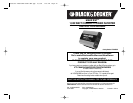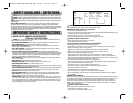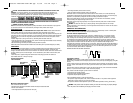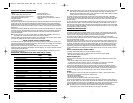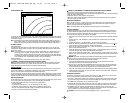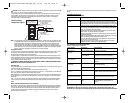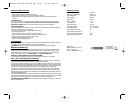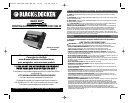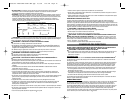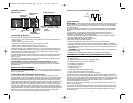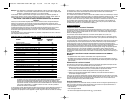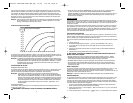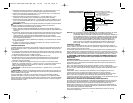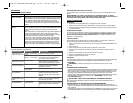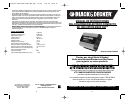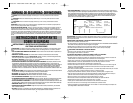
For more information about attaching and using the Remote Control, please refer to the Remote Control User’s
Manual.
TROUBLESHOOTING
Common Audio/Visual Problems
Fault Protection and Troubleshooting Guide
INVERTER POWER SWITCH TURNED ON
Resetting the Unit
When a thermal shutdown problem occurs, the inverter will reset and turn back on automatically after it cools.
WARNING: To reduce the risk of injury or property damage: If the appliance stops working, even
momentarily, turn off the appliance and disconnect from the inverter until the cause is identified and corrected.
Trouble/Indication Possible Cause Suggested Remedy
No AC output —
red LED lit
DC input is below 10 volts Recharge or replace battery.
Excessive appliance load —
thermal shutdown
Turn unit OFF. Reduce the load, wait for the inverter
to cool down, then turn the unit ON again.
No AC output —
green LED not lit
Fuse(s) open Check DC input — fuse(s) in vehicle. Replace the
fuse with one of the same type and rating if
necessary.
Low battery alarm sounds
continuously
Low battery voltage Recharge battery. Remove load from the inverter
while recharging battery.
Bad connection or wiring Tighten all DC connections.
Motorized power tool will
not start
Excessive start-up load If appliance does not start, appliance is drawing
excessive voltage and will not work with inverter.
Motorized power tool does
not operate at correct speed
Purely inductive load Make the load not purely inductive. Operate an
incandescent lamp at the same time as motor.
Television/radio interference Snow in picture, “buzzing”
sound
Keep inverter and antenna distant from each other.
Use shielded antenna. Connect antenna to
amplifier.
Problem Solution
“Buzzing” sound in audio
systems
Some inexpensive stereo systems and “boom boxes” emit a buzzing sound from
their speakers when operated from the Power Inverter. This occurs because the
power supply in the electronic device does not adequately filter the modified sine
wave produced by the inverter. The only solution to this problem is to use a higher
quality sound system that incorporates a higher quality power amplified supply.
Television Interference The Inverter is shielded to minimize interference with TV signals. However, in
some instances, some interference may still be visible, particularly with weak TV
signals. Try the following corrective measures:
• Position the inverter as far as possible from the television, the antenna and the
antenna cables. Use an extension cable, if necessary.
• Adjust the orientation of the inverter, the antenna cables and the TV power cord
to minimize interference.
• Make sure the antenna feeding the television provides an adequate (“snow free”)
signal and that high quality, shielded antenna cable is used.
• Do not use the inverter to operate high-power appliances or tools at the same
time you are using it to operate the TV.
• Make sure the inverter’s case is properly grounded (refer to the “Permanent
Installation Procedure” section of this Instruction Manual).
11
CAUTION: Violation of these requirements may result in unsafe operation and/or equipment failure. Damage
to the inverter as a result of improper installation voids the warranty.
The DC power source must be a well-regulated DC power supply as typically found in vehicle and deep-cycle
marine batteries. The DC power source may also be two 12 volt batteries connected in parallel. On larger
applications the power source may be several batteries connected in parallel as shown in the following
“Permanent Battery Configuration” diagram.
Note: For typical heavy-duty uses in a Permanent Installation, an ANL fuse must be added as close
as possible to the power source (battery) positive terminal. The fuse amperage size must be
appropriate to allow simultaneous operation of all the AC appliances to be powered, with
delay characteristics that allow for the momentary high start-up current requirements of
inductive loads. Use the specified fuse block (fuse holder) and fuse. For full rated output and
motor start-up surge output, ensure that the installation is configured to handle the full load.
See the “Permanent Installation” section of this Instruction Manual.
Connection To Load
The Power Inverter is equipped with standard North American three-prong type outlets. Plug the cord from the
equipment you wish to operate into the AC outlet(s). Make sure the combined load requirement of your
equipment does not exceed maximum continuous power.
The Power Inverter is engineered to be connected directly to standard electrical and electronic equipment in the
manner described above. Do not connect the Power Inverter to household or RV AC distribution wiring. Do not
connect the Power Inverter to any AC load circuit in which the neutral conductor is connected to ground (earth)
or to the negative of the DC (battery) source.
WARNING: TO REDUCE THE RISK OF FIRE, ELECTRIC SHOCK, PROPERTY DAMAGE OR PERSONAL INJURY:
NEVER connect unit directly to AC distribution wiring.
Operating Tips
For best operating results, the inverter should be placed on a stable, flat surface. The inverter should only be used
in locations that meet the following criteria:
DRY — Do not allow water or other liquids to come into contact with the inverter.
COOL — Surrounding air temperature should be between –0°C and 40°C — ideally between 15°C and 25°C (60-
80°F). Keep the inverter away from direct sunlight, when possible.
WELL-VENTILATED — Keep the area surrounding the inverter clear to ensure free air circulation around the unit.
Do not place items on or over the inverter during operation. The unit will shut down if the internal temperature
gets too hot.
SAFE — Do not use the inverter near flammable materials or in any locations that may accumulate flammable
fumes or gases. This is an electrical appliance that can briefly spark when electrical connections are made or
broken.
Notes on Using the Remote Control (sold separately)
For ease of use, Vector offers (as a separate item) a Remote Control specifically designed for this line of MAXX
SST inverters. The inverter ON/OFF Switch must be in the OFF position when connecting the Remote Control to
the unit or the Remote Control will not operate. Once the unit has been turned ON using the Remote Control,
inverter operation will continue to be controlled through the Remote Control. Turn the inverter OFF before
disconnecting the Remote Control.
BATTERY CHARGING
FROM COMMERCIAL
AC, ENGINE, SOLAR, ETC.
BATTERY
BATTERY
BATTERY
BATTERY
(MAX FEET OF
AWG WIRE)
(See the “Specifications” section)
ANL FUSE
FUSE HOLDER
(MAX FEET OF
AWG WIRE)
(See the “Specifications” section)
FUSE TO BATTERY LENGTH
+ FUSE TO INVERTER LENGTH
MAXX SST™
POWER
INVERTER
Permanent Battery
Configuration Diagram
10
90550750 VEC049DCB GOOD ONE.qxp 6/5/09 1:46 PM Page 10



